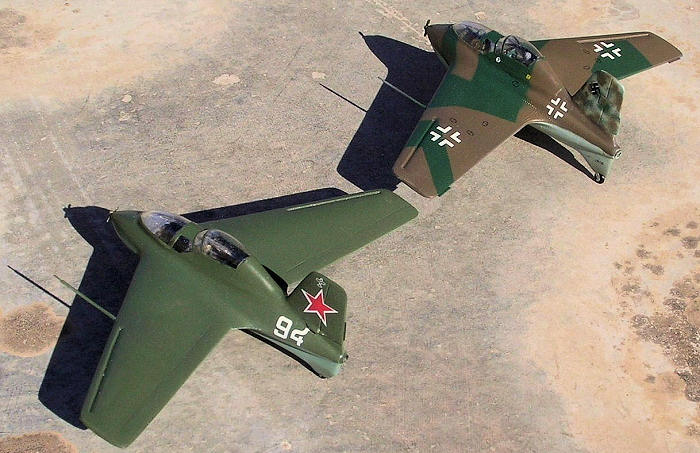
Pavla 1/72 Me-163S
| KIT #: | 72020 |
| PRICE: | $ |
| DECALS: | Two Options |
| REVIEWER: | Carmel J. Attard |
| NOTES: | Short run injection moulded kit with metal etch parts and vac form canopy |

| HISTORY |
The
rocket-powered Me-163 Komet owed its existence to Dr Alexander Lippish who had
begun design tailless gliders in 1926. Over the years, Lippish had designed
several successful tailless gliders, a few of which featured a delta wing
design. In 1939 Lippish was asked by the German Air Ministry to come up with a
design to utilize a new secret, rocket engine, the Walter J-203 that produced
882 lbs of thrust.
The new rocket propelled plane
never developed as it had been hoped. Instead of metal fuselage, Lippish fitted
an all wood airframe design called 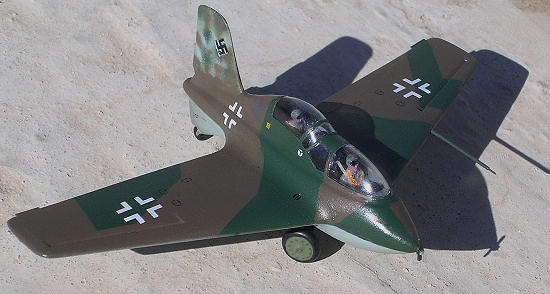 development
led to the evolvement
of a high-speed, fast climbing
interceptor that could stay on the ground until the enemy was almost overhead.
With this strategy, the brief endurance of the rocket-powered flight would not
be a negative factor. Thus was born the Me-163. Further development on the
programme continued and despite
the bombing of
development
led to the evolvement
of a high-speed, fast climbing
interceptor that could stay on the ground until the enemy was almost overhead.
With this strategy, the brief endurance of the rocket-powered flight would not
be a negative factor. Thus was born the Me-163. Further development on the
programme continued and despite
the bombing of
The Me-163B
was equipped with two 30mmcannons mounted in the wing roots. The aircraft
featured a revised 16B gun sight, a 90mm armoured glass beneath the plexiglass
canopy and armour behind the pilotís back over the nose cone. Nearly 300 Me-163s
were in front line service at the end of the war but the aircraft gained only 9
victories. Although casualties were high in the Me-163 units only 14 of the
aircraft were lost in combat. A full 80% of the losses came during landings and
take offs. The Me-163 was an exceptional aircraft many years ahead of its time
in many of its features. Undoubtedly it was much better psychological weapon
than it was an interceptor.
On
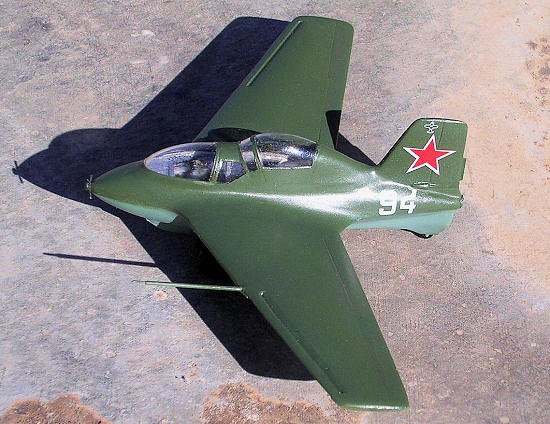 It was
flown purely as a glider, being towed off the ground by a Bf-110. Following
trials a decision was reached to produce 42 of the S two seaters. The S version
had a differently shaped instructorís canopy. Only a small number were
completed, as the combat version was more important. A few Komets including some
two or three Me-162S were acquired by the
It was
flown purely as a glider, being towed off the ground by a Bf-110. Following
trials a decision was reached to produce 42 of the S two seaters. The S version
had a differently shaped instructorís canopy. Only a small number were
completed, as the combat version was more important. A few Komets including some
two or three Me-162S were acquired by the
Editor's Note: I think Carmel's information on the 163S might be a bit out of date. According to 'Me-163, volume 2' by Classic Books, 2003, the Me-163S mock-up was not initially inspected until 23 June 1944 with the first towed flight taking place on 29 December 1944. Most of the few 163S airframes were converted from B models as the contract for 30 163S planes was cancelled in November 1944 after only two examples had been built. The handling qualities of the aircraft were said to be good, but the instructor's inability to see during landings (the primary purpose of developing the two seat version) made the aircraft unacceptable to operational units and the type was was never used in training. Apparently what few flights made in this aircraft were towed and the book could not find instances of powered flights undertaken either the Luftwaffe or by the Soviets who captured several of these aircraft.
| THE KIT |
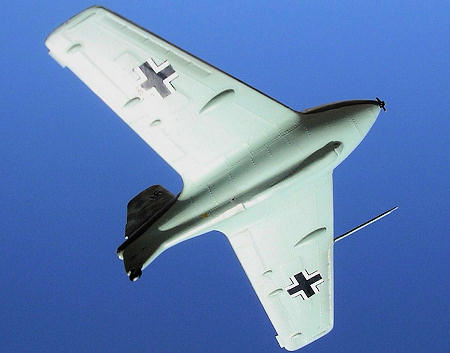 Pavla
has made its name with successive release of WW2 combat aircraft and I believe
was also the first to issue the Me-163S to the 1/72 scale market and to include
brass etch parts in its kits on an almost regular basis. The Me-163S was built
in a very limited numbers, a practically underpowered conversion trainer that
was used to familiarise the rocket interceptor pilots with take offs and
landings of the little winged aircraft.
Pavla
has made its name with successive release of WW2 combat aircraft and I believe
was also the first to issue the Me-163S to the 1/72 scale market and to include
brass etch parts in its kits on an almost regular basis. The Me-163S was built
in a very limited numbers, a practically underpowered conversion trainer that
was used to familiarise the rocket interceptor pilots with take offs and
landings of the little winged aircraft.
| CONSTRUCTION |
The first stage of construction deals with the assembly of the two separate crew offices. The front instruments and side consoles are the first items to start with, and then add the crew seats complete with the seat straps in brass. At the back of the rear seat there is a firewall item, which is then fixed in place. More interior detail comes in form rudder pedals, control sticks, and control handles to fit to sides of cockpit. A side view section drawing clearly show how the two cockpits are staggered making the seating arrangement at different level so that the rear instructor seat is more elevated giving an unobstructed view.. The vac form canopies are very clear and it
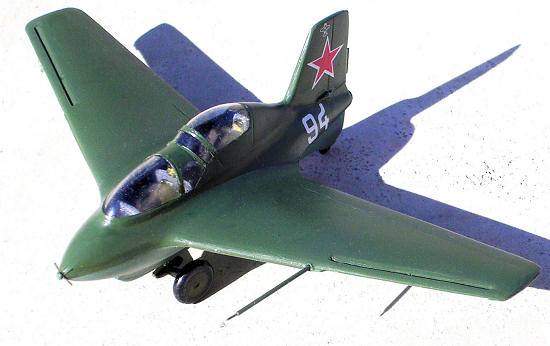 is
a pity to leave these in the closed position since some of the interior detail
comes hidden. The wings, which come into four parts, may contain a trim tab to
the aileron and this applies to the German version only. There is a choice of
assembly to the tail wheel in faired or unfaired position. This has to conform
to the position of the undercarriage skid, which can be fitted either retracted
or extended. The skid carries the main wheel dolly.
is
a pity to leave these in the closed position since some of the interior detail
comes hidden. The wings, which come into four parts, may contain a trim tab to
the aileron and this applies to the German version only. There is a choice of
assembly to the tail wheel in faired or unfaired position. This has to conform
to the position of the undercarriage skid, which can be fitted either retracted
or extended. The skid carries the main wheel dolly.
A long antenna is fitted to the port wing leading edge. This I replaced with one made of steel since it is prone to breaking. This had equal length and thickness to the plastic kit antenna. I experienced no difficulty with the fit of parts and if one elects to fix the skid in the extended position as it should be when the aircraft is in landing mode one should make use of super glue to fix the brass etch bracket details that go with the skid. The rudder trim tab also comes in form of a rectangular brass piece, which gives the scale effect. The wing joints to the fuselage needed a little filler followed by smoothening with wet and dry.
| COLORS & MARKINGS |
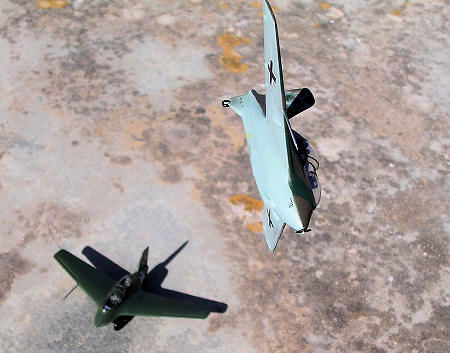 The
cockpit interior basically consists of floor; bulkhead and side panelling are
Grey RLM2, the rest in RLM66 Schwartzgrau and the seats in RLM71 Dunkelgrun. The
camouflage colours for the two me-163s differed. The Soviet 163S, made from the
Pavla kit has Russian Green Humbrol 114 upper camouflage while the lower
surfaces were Russian blue Humbrol 115. The German one was finished in RLM 81,
82 and 76. For the splinter camouflage I used Compucolor CG25 (RLM 81) Brown
Violet and Compositor CG 26 (RLM 82) Dunkelgrun. The lower surfaces were
airbrushed in Compucolor CG 19 (RLM 76) Hellgrun. The airbrushed models were
given a coat of Klear prior to sliding on the decals.
The
cockpit interior basically consists of floor; bulkhead and side panelling are
Grey RLM2, the rest in RLM66 Schwartzgrau and the seats in RLM71 Dunkelgrun. The
camouflage colours for the two me-163s differed. The Soviet 163S, made from the
Pavla kit has Russian Green Humbrol 114 upper camouflage while the lower
surfaces were Russian blue Humbrol 115. The German one was finished in RLM 81,
82 and 76. For the splinter camouflage I used Compucolor CG25 (RLM 81) Brown
Violet and Compositor CG 26 (RLM 82) Dunkelgrun. The lower surfaces were
airbrushed in Compucolor CG 19 (RLM 76) Hellgrun. The airbrushed models were
given a coat of Klear prior to sliding on the decals.
| CONCLUSIONS |
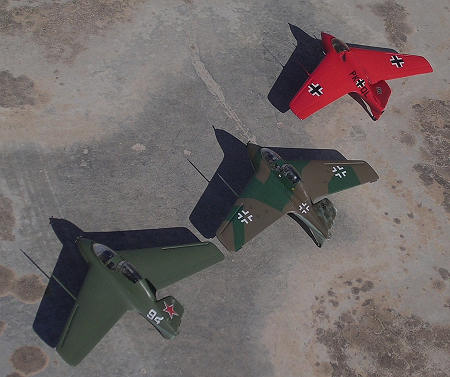 The Pavla Me-163S is a tiny little aircraft kit and
an easy short run type to build. It had a peculiar history whose power plant
with all its complex chemical fuel mixtures was probably more lethal to the crew
who flew it than it was to the enemy. Nevertheless they proved a good start of a
new concept in rocket-powered interceptors, which was later, evaluated further
when the war ended.
The Pavla Me-163S is a tiny little aircraft kit and
an easy short run type to build. It had a peculiar history whose power plant
with all its complex chemical fuel mixtures was probably more lethal to the crew
who flew it than it was to the enemy. Nevertheless they proved a good start of a
new concept in rocket-powered interceptors, which was later, evaluated further
when the war ended. June 2009
If you would like your product reviewed fairly and quickly, please contact me or see other details in the Note to Contributors.